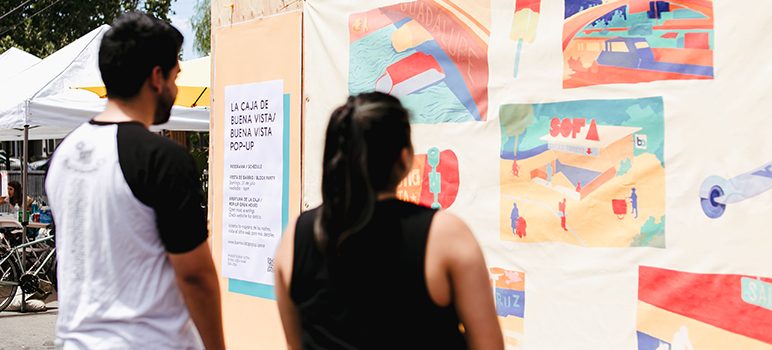A large metal box about the size of a taco truck sits along the curb of Scott Street next to Buena Vista Park in San Jose. If it weren’t for the signs identifying it as an office of sorts, the hulking metal structure could be mistaken for a shipping container home.
It is, in fact, a pop-up organized by San Jose’s Department of Transportation (DOT), the Mayor’s Office of Technology and Innovation and design firm IDEO, which partners with Gehl. For two weeks, thanks to a Knight Foundation grant, the pop-up has stood on the asphalt, welcoming locals to join a team of fellows and researchers in conversation.
The goal: to redesign community engagement in neighborhoods like Buena Vista to include people who haven’t been included in civic dialogue before.
The city of San Jose is tinkering with the idea of autonomous vehicles (AV) in formal partnership with the private sector after releasing a request for information in 2017. They asked private companies to test AV in the city, hoping the technology could equip the underserved with mobility alternatives as well as incentivize people to drive their own cars less and reduce emissions.
San Jose is interested in the possibility of using AV on set taxi routes and wants to implement pilot tests. One such route runs from Diridon to Valley Fair along West San Carlos Street, which would impact the Buena Vista neighborhood.
Proponents say routes like this have the potential to do a world of good.
Autonomous taxi routes could benefit people with disabilities and get students to school, residents to the local community center, or the hospital, says Dennis Yu, a graduate student intern at San Jose’s DOT.
DOT Innovation Program Manager Jill North, says, “It’s really about the public sector and the private sector speaking the same language and learning how to work together in a way to actually move the needle forward, rather than having friction.” She explains that the city wants to leverage the power of AV technology and the data it provides to enhance the safety of the transportation system.
Yet before diving into pilot testing, the city decided to take some time to understand the needs and wants of the communities to be impacted. The team behind the pop-up hopes to get to know the community to the point that the city can begin to make a legitimately helpful difference with new technologies. It’s a goal that seems to deepen the vision of a representative democracy.
That aim appears central to the work of Joanne Cheung, leader of the Collaborative Cities portfolio at IDEO CoLab in San Francisco and project manager for the pop-up. She explains that communities aren’t usually able to give any more input than a “yes” or “no”—let alone contribute to nuanced discourse and design.
“The origin of the project is the realization that in the context of emerging technologies, you need to have it ultimately serve everyone,” Cheung says. “You need to co-plan it with everyone in the very beginning. The challenge with representative democracy in these larger areas is that you have to have more effective measures to figure out how to do that, so you have to be strategic. When is the best time, where is the best place to meet people where they are, what are some questions to ask them such that that actually have direct input into real things that are happening in the city?”
She adds, “We need better models for collaboration.”
Hence, a pop-up sprouting in Buena Vista’s most walked-through spot, and a bilingual block party chock full of different participatory opportunities for diverse members of the community was held July 21. Kids whack rainbow-colored balls down the sidewalk in their own version of mini-golf and draw pictures of the people they travel with.
Other attendees draft love letters to their favorite places in San Jose.
Emily Parent, who moved here from the East Coast just a month ago, runs a CreaTV-sponsored podcast on the curb of the cordoned-off street, where visitors share reflections about the community.
The event is an impressive feat for a team that conceived of the project only three weeks prior, and the pop-up will continue to stand for the next week or so in order to keep collecting feedback from the community and to establish a relationship with residents.
“I do think at this moment in this country’s history, it’s quite necessary,” Cheung says. This is the babiest of baby steps, but I do think that it’s not just about transportation, or any topic or thing. We want to have more actively engaged citizens for the model of this country to flourish.”
Organizers say this is just the beginning of what they hope will become a deep collaboration between the city and its people.


Diridon to Valley Fair? You mean one of the ABSOLUTELY BEST serviced VTA corridors? If you need an AV taxi to get you between Diridon and Valley Fair then you probably also need an augmented attendant to wipe your butt. What a tremendous waste of resources.
> “We need better models for collaboration.”
If I were king:
“I want a report on my desk by 5 PM today listing every cent the taxpayers a spending on this stupid pipe dream, and every man-hour, and woman-hour, and transgender-hour of city employee time wasted on it, AND I WANT IT STOPPED!!!”
“Send the money over to the pothole repair department, and fire the drones wasted time on this or teach them to fill potholes”.
“And, ask public works if our models for collaboration are good enough. If they don’t think so, tell them to cut bonuses and days off.”